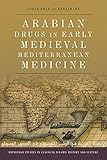Arabian drugs in medieval Mediterranean medicine /Zohar Amar and Efraim Levy.
Material type: TextSeries: Publication details: Edinburgh : Edinburgh University Press, (c)2017.Description: 1 online resourceContent type:
TextSeries: Publication details: Edinburgh : Edinburgh University Press, (c)2017.Description: 1 online resourceContent type: - text
- computer
- online resource
- 9780748697823
- 9781474413183
- RS180 .A733 2017
- COPYRIGHT NOT covered - Click this link to request copyright permission: https://lib.ciu.edu/copyright-request-form
| Item type | Current library | Collection | Call number | URL | Status | Date due | Barcode | |
|---|---|---|---|---|---|---|---|---|
 Online Book (LOGIN USING YOUR MY CIU LOGIN AND PASSWORD)
Online Book (LOGIN USING YOUR MY CIU LOGIN AND PASSWORD)
|
G. Allen Fleece Library ONLINE | Non-fiction | RS180.65 (Browse shelf(Opens below)) | Link to resource | Available | ocn981811641 |
Browsing G. Allen Fleece Library shelves, Shelving location: ONLINE, Collection: Non-fiction Close shelf browser (Hides shelf browser)
Includes bibliographies and index.
Introduction -- Agriculture and pharmaceutical innovations: milestones in research and case studies -- 'Arabian' substances -- Discussion and conclusion -- Bibliography -- Indexes.
For more than one thousand years Arab medicine held sway in the ancient world, from the shores of Spain in the West to China, India and Sri Lanka (Ceylon) in the East. This book explores the impact of Greek (as well as Indian and Persian) medical heritage on the evolution of Arab medicine and pharmacology, investigating it from the perspective of materia medica - a reliable indication of the contribution of this medical legacy. Focusing on the main substances introduced and traded by the Arabs in the medieval Mediterranean - including Ambergris, camphor, musk, myrobalan, nutmeg, sandalwood and turmeric - the authors show how they enriched the existing inventory of drugs influenced by Galenic-Arab pharmacology. Further, they look at how these substances merged with the development and distribution of new technologies and industries that evolved in the Middle Ages such as textiles, paper, dyeing and tanning, and with the new trends, demands and fashions regarding spices, perfumes, ornaments (gemstones) and foodstuffs some of which can be found in our modern-day food basket. Explores the impact of drugs introduced by the Arabs on medieval Mediterranean medicine. For more than one thousand years Arab medicine held sway in the ancient world, from the shores of Spain in the West to China, India and Sri Lanka (Ceylon) in the East. This book explores the impact of Greek (as well as Indian and Persian) medical heritage on the evolution of Arab medicine and pharmacology, investigating it from the perspective of materia medica - a reliable indication of the contribution of this medical legacy.Focusing on the main substances introduced and traded by the Arabs in the medieval Mediterranean - including Ambergris, camphor, musk, myrobalan, nutmeg, sandalwood and turmeric - the authors show how they enriched the existing inventory of drugs influenced by Galenic-Arab pharmacology. Further, they look at how these substances merged with the development and distribution of new technologies and industries that evolved in the Middle Ages such as textiles, paper, dyeing and tanning, and with the new trends, demands and fashions regarding spices, perfumes, ornaments (gemstones) and foodstuffs some of which can be found in our modern-day food basket. Key Features. Assesses the assimilation of theoretical and practical Greek, Indian and Persian medicine into Arabic medical culture Reconstructs and presents a list of medicinal substances distributed by the Arabs as a result of their conquests Tells the stories of 33 new Arabic drugs within the context of their natural history Describes the contribution of the Arabs to the daily medieval cultural material (medicine, cosmetics, perfumery, dyeing of materials, industrial products and precious stones) Includes 35 colour illustrations
COPYRIGHT NOT covered - Click this link to request copyright permission:
There are no comments on this title.







